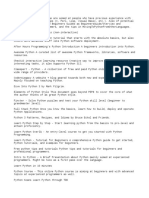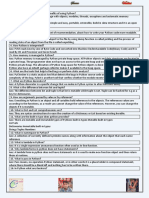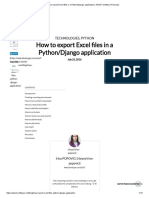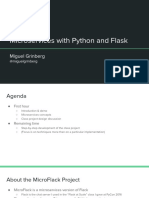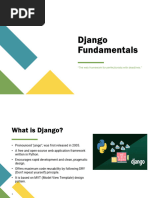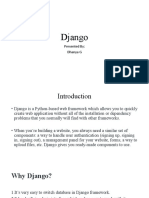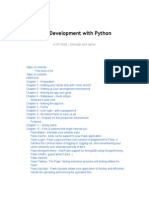0 ratings0% found this document useful (0 votes)
1K viewsPython Flask Tutorial
Flask is a popular Python web framework that is easy to learn and implement. It has good documentation and requires only two external libraries: Werkzeug for the WSGI interface and Jinja2 for templating. A minimal Flask app imports the Flask class, creates an app instance, defines a route decorator for the view function, and runs the local development server. Blueprints allow supporting common patterns, registering URL prefixes, and providing additional resources like templates and static files. The document then provides an example of a minimal Flask app and discusses url_for, view methods, and blueprints before moving on to introduce Pymongo for working with MongoDB.
Uploaded by
Shashank DixenaCopyright
© © All Rights Reserved
Available Formats
Download as ODT, PDF, TXT or read online on Scribd
0 ratings0% found this document useful (0 votes)
1K viewsPython Flask Tutorial
Flask is a popular Python web framework that is easy to learn and implement. It has good documentation and requires only two external libraries: Werkzeug for the WSGI interface and Jinja2 for templating. A minimal Flask app imports the Flask class, creates an app instance, defines a route decorator for the view function, and runs the local development server. Blueprints allow supporting common patterns, registering URL prefixes, and providing additional resources like templates and static files. The document then provides an example of a minimal Flask app and discusses url_for, view methods, and blueprints before moving on to introduce Pymongo for working with MongoDB.
Uploaded by
Shashank DixenaCopyright
© © All Rights Reserved
Available Formats
Download as ODT, PDF, TXT or read online on Scribd
You are on page 1/ 2
Python Web Frameworks:
Django, Flask, Pyramid, Tornado, Bottle, Diesel, Pecan, Falcon
Flask:
Two external libraries:
Werkzeug Toolkit for WSGI (Standard Python Interface between Application and Server)
Jinja2 Template Engine (Renders templates)
Advantages:
- Easy to learn & implement
- Good documentation
Installation:
pip install Flask
Minimal Application:
from flask import Flask
app = Flask (__name__)
@app.route ('/')
def hello ('/'):
return 'Hello World!'
if __name__ == '__main__'
app.run ()
What we did above?
- Imported Flask class
- Created a single module instance '__name__'
- Used 'route' decorator to tell what url should trigger our 'hello' function
- Defined a 'hello' function (also helpful in generating the url later using url_for)
- Used 'run' function to run the local server
Debug Mode:
app.run (debug = True)
Url Building:
url_for( 'function_name' ) generates the url corresponding to the function_name
Url Methods:
@bp.route ( '/login', methods = [ 'POST', 'GET', 'DELETE', 'PUT', 'SEARCH' ]) and the like
Blueprint:
from flask import Blueprint
bp = Blueprint('bp', __name__)
Eg. app.register_blueprint(bp, url_prefix='/cat-ui')
#appends cat-ui prefix to all urls while generating them
url_for( 'bp.function_name' )
Why Blueprints?
- Supporting common patterns throughout the application
- Register default prefixes in application url
- Provide template filters, static files, etc.
Demo:
- Minimal Application
- Text box for sub-category change
- Overview of Product Catalog Tagging
Moving ahead with Pymongo:
- $addToSet (To append a new item in a list of value of a field)
- $group (Aggregates documents by desired key values)
- $match (Matches aggregated documents over a constraint)
- $project (Generates desired names for queries)
References:
http://flask.pocoo.org/docs/0.10/quickstart/#
http://opentechschool.github.io/python-flask/
You might also like
- The C# Player's Guide - 5th Edition - 5.0.083% (18)The C# Player's Guide - 5th Edition - 5.0.0497 pages
- Introduction To Computer Theory by Cohen Solutions Manual80% (5)Introduction To Computer Theory by Cohen Solutions Manual198 pages
- Ap Computer Science Principles Practice Exam and Notes 202186% (7)Ap Computer Science Principles Practice Exam and Notes 2021108 pages
- Hacking The Art of Exploitation 2nd Edition Jon Erickson100% (20)Hacking The Art of Exploitation 2nd Edition Jon Erickson492 pages
- PrepTest 83 - Print and Take Test - 7sage Lsat100% (3)PrepTest 83 - Print and Take Test - 7sage Lsat46 pages
- Flask: The Cheat Sheet: Flask For Django UsersNo ratings yetFlask: The Cheat Sheet: Flask For Django Users1 page
- Application Development With Tkinter and Mongo DB: CodeNo ratings yetApplication Development With Tkinter and Mongo DB: Code3 pages
- Web Application Development Using Django PDFNo ratings yetWeb Application Development Using Django PDF33 pages
- Api-Demo: Platform-As-A-Service (Paas) Based SolutionNo ratings yetApi-Demo: Platform-As-A-Service (Paas) Based Solution6 pages
- Write Python Instead of SQL!: An Introduction To SqlalchemyNo ratings yetWrite Python Instead of SQL!: An Introduction To Sqlalchemy10 pages
- Python For Web Scraping - Week 3: 1 Installing A ModuleNo ratings yetPython For Web Scraping - Week 3: 1 Installing A Module4 pages
- #Barebones App #Access Request Data #Useful Plugins: Rin Ted .Co MNo ratings yet#Barebones App #Access Request Data #Useful Plugins: Rin Ted .Co M1 page
- Django Made Easy Build and Deploy Reliable Django ApplicationsNo ratings yetDjango Made Easy Build and Deploy Reliable Django Applications250 pages
- Python Console Application Development 2No ratings yetPython Console Application Development 227 pages
- Python Code For Shop Management-WPS OfficeNo ratings yetPython Code For Shop Management-WPS Office14 pages
- Designing A RESTful API With Python and Flask - Miguelgrinberg100% (2)Designing A RESTful API With Python and Flask - Miguelgrinberg14 pages
- How To Export Excel Files in A Python - Django Application - ASSIST Software Romania100% (1)How To Export Excel Files in A Python - Django Application - ASSIST Software Romania13 pages
- Data Analysis by Web Scraping Using PythonNo ratings yetData Analysis by Web Scraping Using Python6 pages
- Python Programming - Exercises: Finn Arup Nielsen50% (2)Python Programming - Exercises: Finn Arup Nielsen30 pages
- Django for Beginners 2 1 William S. Vincent 2024 scribd download50% (2)Django for Beginners 2 1 William S. Vincent 2024 scribd download55 pages
- Coding With JavaScript For Dummies Everything To Know About JavaScript (2020) - 40153100% (1)Coding With JavaScript For Dummies Everything To Know About JavaScript (2020) - 40153247 pages
- NWO, Illuminati, Freemason, Occult, Bible Prophecy, Conspiracy, Secret Society, Etc. LinksNo ratings yetNWO, Illuminati, Freemason, Occult, Bible Prophecy, Conspiracy, Secret Society, Etc. Links47 pages
- Structured and Unstructured Maintenance With Example0% (1)Structured and Unstructured Maintenance With Example9 pages
- Learn To Code HTML and CSS Develop Style Websites PDF100% (2)Learn To Code HTML and CSS Develop Style Websites PDF595 pages
- Python Programming For Beginners - A Crash Course To Learn Python and Other Recommended Coding83% (6)Python Programming For Beginners - A Crash Course To Learn Python and Other Recommended Coding86 pages
- LINUX COMMAND LINE An Introduction To Linux Command Line EnvironmentNo ratings yetLINUX COMMAND LINE An Introduction To Linux Command Line Environment174 pages
- How To Use PATS Module Initialization FunctionNo ratings yetHow To Use PATS Module Initialization Function5 pages






















